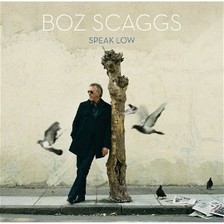Boz Scaggs - Set List Interview
Variety.com - September 29, 2008
Scaggs brought in jazz pianist Gil Goldstein to produce, arrange and lead a quartet that features Bob Sheppard on woodwinds, bassist Scott Colley and drummer Alex Acuna. The repertoire includes a couple of Johnny Mercer tunes (“This Time the Dream’s on Me,” co-written with Harold Arlen, and “Skylark,” co-written by Hoagy Carmichael), Duke Ellington (“Do Nothing till You Hear From Me”), Jobim’s “Dindi” and “I'll Remember April” by Gene De Paul, Patricia Johnson and Don Raye. Goldstein came into Scaggs’ life one rainy night when the singer walked past the Blue Note jazz club and heard vibes, strings and horns – the sounds he wanted to explore on his second venture in this new area. Different as it is from his days blending soul and blues in funky configurations (1969’s “Boz Scaggs” and “Moments”) or slick ones (1976’s “Silk Degrees” and 2001’s underrated “Dig”) he has a pretty keen idea as to the source.
“Bobby ‘Blue’ Bland is the king of them all and I know this stuff (standards) got in there. I even asked Bobby this, and he said it’s through the influence of Nat King Cole,” Scaggs says. “Now there’s also Joe Turner, a little Sinatra, Mel Torme. To have discovered my connection to this wonderful, relevant music has opened a whole new world.” The vinyl version of the album will be released Tuesday, which will make it eligible for this year’s Grammy Awards, and on Oct. 28 in all other forms. He spoke about being intimidated by the jazz musicians in his band, session musicians he has worked with over the years, among them Duane Allman, and how, this time around, he’ll fit some “Silk Degrees” material into his jazz shows Q: This has a much more cohesive feel than your first collection of standards. Did you approach this one any differently? A: Finding the material was stage one. Stage two, I had an idea for a theme, then went about finding the arranger and musical director. Stage three was working into those arrangements. Over the period of three years it came together. There was a lot of searching, a lot of thinking about the concept. Q: It’s clear you are in a room with a band. And the arrangements have been clearly thought out, especially the relationship between your voice and the bass of Scott Colley. It sounds like there’s a dance going on between the two of you, as if the two of you are taking turns leading. How intentional was that? A: You’ve hit on something I hadn’t been aware of. Scott was chosen by Gil Goldstein. He had worked with Shirley Horn and he’s still a young man, but he’s done a lot of work accompanying singers. Gil built in a couple of occasions in the studio in which we had to back off from doing so many Scott’n’ Boz intros. It’s a natural way to begin a song – sparse and open. Q: You have been quoted as saying that this type of music was never really in your background, that so much of the music you learned at a younger age was blues based. What drives the appeal? A: I grew up listening to a lot of different music. When I was a kid it was a transition from America’s hit parade to Fats Domino and Elvis Presley. That happened very, very quickly and in the sixth grade and seventh grade our heroes were on the radio. The most profound influence at the time was the Texas blues musicians like T-Bone Walker plus Ray Charles and Fats and all the singers out of New Orleans. Bobby “Blue” Bland was the greatest of them all. Ray moved into standards and that was way out of my experience. Q: One thing this does, though, is reduce the amount of guitar you play. Can you increase your role when you do concerts? A: On the record I only play on one song. No. 1, I want to play (guitar in concert). It’s terrifying. I don’t have a great microphone technique so I want to be able to stand there with a guitar in my hands, playing the chord changes. I’m learning the parts but it’s a real challenge as a guitar player. One of the things, and it’s a little bit of an enigma, in the ’70s I would choose great musicians for sessions. When its time for me to go out on the road I have always had to find my own way and do what they did in the studio. I’m so intimidated, but I always want to be a part of the ensemble. Q: When you make a dramatic shift, and over the last decade or so you have balanced blues bands with your pop work, what do you have to do to keep the hits in the set list? Or is that even important? A: After the first album of standards, “But Beautiful,” I did more touring than I had through my whole career. With a four-piece jazz group, we did a lot of Europe, a week in New York, Japan, Chicago, L.A. I was able to get away from the hit material. Now I have begun to adapt some of the songs. It’s nice to see the songs come back in. In some ways you’d like to redefine yourself, but the connection (to the fans) is that stuff. There are artful ways to include them. Gil and I have worked on “We’re All Alone” and “Lowdown.” In a way you’d like to be somebody new, but the responsibility of everyone I know who has been doing this for a long time is to include (their hits). It stays fresh when you keep great musicians; the songs become redefined. Q: What about “Harbor Lights”? I have always loved your version. A: “Harbor Lights” is always in there.
|
|||||||


